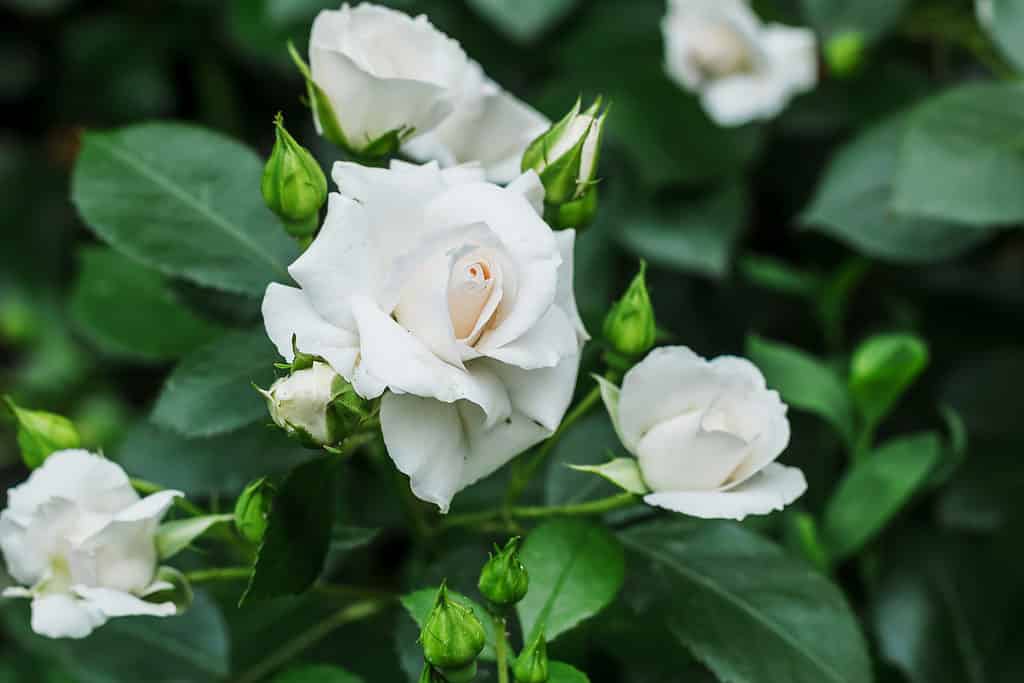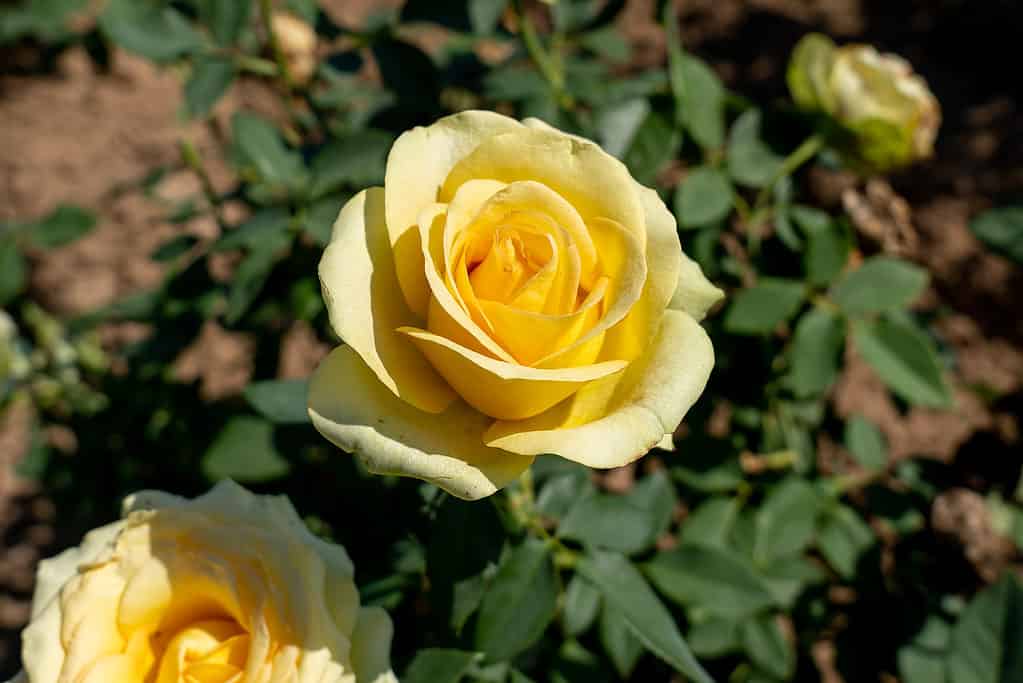When we think of flowers, we typically picture a fully developed blossom in various hues, mostly red, pink, white, orange, and gold. Due to these lovely colors, even bees and butterflies would undoubtedly know where to get the sustenance they need.
Flowers stand out from most other plant parts because of their vibrant hues, but what if flowers were also green? Would we, the bees, and the butterflies still be drawn to our favorite rose if it were green instead? Believe it or not, green roses actually do exist, and they are quite pretty!
In this guide, we’ll explore a few different green rose varieties and everything you need to know about them, from their origins to why they exist.
How Do Green Roses Exist?
To better understand how a rose can be green, it helps to understand that flower petals are likely just evolved leaves.
The sepals, which guard the unopened bud; the petals, which are often brightly colored; the stamen, or the male reproductive portion; and the carpel, or the female reproductive organ, make up the majority of flowers’ four rings or whorls. According to scientists, these whorls were formerly leaves that underwent an evolutionary change to enable reproduction in plants.
The colorful petals that are the consequence of this transformation draw pollinators like bees and butterflies, who spread pollen to other flowers and frequently cross-breed them. The vibrant variety of rose blooms is another factor in why people collect and cross-breed them.
Green Rose Features
Green roses are extremely uncommon and do exist in nature, unlike black or blue roses. Sepals were eventually discovered to be the green, leaf-like structures that had replaced the flower’s red, pink, or yellow stamen, carpel, and petals.
The aberrant transformation of floral components into leafy structures, known as phyllody, is thought to be the outcome of a random mutation. Since the flower is primarily formed of layers of sepals and has no reproductive organs, there won’t be any pollination, and no seeds will be created for this rose plant’s subsequent generation. Cuttings and graftings can be used to spread the unusual plant instead.
The Viridiflora rose is a wonderful illustration of how green roses function. Since “viridiflora” means “green flower,” the rose plant is now commonly referred to as the green rose. It develops into an evergreen shrub with brightly colored reddish-green foliage. Although the bloom doesn’t resemble a rose, the clump of sepals has an apple-green hue with bronze ends and a somewhat peppery aroma.
Green roses are unusual-looking and stand out in floral arrangements. They also perform well in the garden, especially in the winter, thanks to their hardiness and repeat blooming abilities.

It is believed that flower petals (pictured) are simply evolved leaves, which always start out as green due to chlorophyll.
©Viktoriia Lozova/Shutterstock.com
The History Of Green Roses
Green roses are uncommon and lovely flowers. Green roses do genuinely naturally grow in the wild, despite being uncommon. But the majority of these roses are grown for the floral industry. So how did green roses come to be so well-liked?
In the 18th century, China is where green roses were first documented. They belonged only to the monarch and were cultivated in the renowned Forbidden City. Then, in 1856, green roses were made available to the general public by the British nursery Bembridge and Harrison. These plants were renowned for having large blooms. Because the English people loved them so much, word of these magnificent blooms quickly traveled around the globe. Although less well-known than the traditional red rose, they are nevertheless beautiful to see.
The Meaning Of Green Roses
Numerous things may be interpreted from green flowers. They are most frequently recognized as representations of fertility and optimism. Their hue also stands for vitality, renewal, and joy. Green, on the other hand, is a hue connected to jealousy. Fortunately, green roses rarely convey this idea; instead, they tend to convey a feeling of balance and freshness.
Green is a traditional earth tone that is frequently used as a metaphor for material wealth, fertility, and prosperity. Sending someone a bouquet of green roses is a traditional way to express happiness and hope for new beginnings. These roses also represent rebirth and regeneration, the revival of one’s life and spirit, as green is the color of nature.
There are several uses for green roses. They look fantastic as Christmas, Easter, and St. Patrick’s Day decorations. And when you want to bring a sense of hope and freshness into your house, nothing beats a stunning arrangement of green roses.
Varieties Of Green Roses
Super Green Rose
Botanical Name: Rosa ‘Super Green’
This unique green rose has a bright spring-green color with quite large flowers. It does not have a scent, and it has an almost cabbage-like appearance. This is a green basic green rose to use for flower arranging and bouquets, especially if you’re looking for something with a fresh floral appeal. We recommend mixing this rose with smaller, darker-hued flowers or miniature roses.
Mayra’s Green Rose
Botanical Name: Rosa ‘Mayra’s Green’
A gorgeously ruffled green garden rose variation from the Mayra collection is the Mayra’s Green rose. This variety’s petals are a lighter shade of green on the outside and creamy chartreuse on the inside. This type gives any design a beautifully romantic, but natural appearance.
Mint Julep Rose
Botanical Name: Rosa ‘Mint Julep’
Despite being mostly yellow, this rose is dubbed a green rose because its petals have a green border. On the petal edges, the borders are mint green in hue. They have lovely hues that are light and delicate, giving them a gentle and welcoming aspect. They can be cultivated in gardens or used as decorations for special events.
Greensleeves Rose
Botanical Name: Rosa ‘Greensleeves’
This rose looks really stunning and has a marine green tint. It has a distinctive and interesting character. These roses look stunning when set against lush green greenery. By mixing them with roses of other colors, such as red, white, yellow, or lavender, they may be utilized as decorations. The pink buds of this rose open into medium-sized, semi-double blooms that soon change from parchment pink to green. The blooms are useful for floral decorations since they develop in enormous, thick clusters of up to 12 to 15 flowers and remain on the plant for a very long period.
Viridiflora Rose
Botanical Name: Rosa viridiflora or Rosa chinensis
This green rose is a member of the older species of roses and has no scent. They stand out mostly due to their color and toughness. These roses may be cultivated in gardens or flower pots and have good repeatability. They give any garden a special touch. Although the buds of Green Rose blooms resemble those of other roses, no petals are present when they open. Sepals are stacked on top of one another to form the rose flower. Sepals typically join to create the flower’s holder or the calyx. The Viridiflora green rose, however, never produces a genuine blossom. No blossom means no seed, which means the rose plant cannot reproduce. This plant only survives as a result of the generosity and affection of gardeners who divide roses into cuttings to grow more roses.

The Viridiflora rose (pictured) is an excellent example of an old-world green rose.
©Edita Medeina/Shutterstock.com
Green Ice Rose
Botanical Name: Rosa ‘Green Ice’
These little flowers have a lovely appearance that is rare in the world of roses. They are beautiful garden flowers and have an ice-green color. They are fantastic flowers to grow as potted plants inside an apartment or as a part of a terrace garden since they are little roses. This rose may be used as a container rose, cut flower, garden, ground cover, hanging basket, landscape, pillar, or shrub. It thrives in USDA hardiness zones five through 10.
St. Patrick Rose
Botanical Name: Rosa ‘WEKamanda’
Although these roses have a bright lemon-yellow color, heat and sunlight bring out their greenish undertones. When the sun shines, they appear attractive in a garden. They are fantastic roses for bridal or bouquet decorations since they go so well with white. This hybrid yellow tea with a tinge of green enjoys and benefits from heat. The yellow in the blooms is enhanced by cooler temperatures, but when the weather warms up, the unusual green hue emerges. This disease-resistant plant has gray-green leaves, although it is a little fragile in the winter, so take care.

The yellow and green St. Patrick rose (pictured) makes an excellent gift due to its unique coloring.
©JHVEPhoto/Shutterstock.com
Green Tea Rose
Botanical Name: Rosa ‘Green Tea’
These roses are named after the beverage green tea and have a matcha-like color. They are lovely roses to have around in a garden or at home because of their delicate green hue. The pale green bud of the green tea rose is exquisite. It may offer a splash of color to any bouquet, as most flowers with light hues can. Its organic green tone inspires lovely springtime thoughts in the mind. They may be combined and utilized in bouquets, centerpieces, and other flower arrangements.
Green tea roses are well-liked during celebrations around St. Patrick’s Day because of their natural green tint. Due to the expression “green with envy,” this flower is occasionally misunderstood to signify jealousy, although it really historically denotes a natural and fertile beauty. It is a well-liked present for expectant mothers.
Artificial Green Roses
Botanical Name: N/A
It’s worth noting that many green roses you will see at grocery stores, nurseries, and florists will be dyed green. Green artificial color can be applied to a rose. A white rose that has been painted any shade of green may be used for this. This would be a fantastic choice for decorating with a theme. It may be painted any shade of green, including marine, dark, or light. Since many of the green roses on our list are not 100% green and are quite rare or expensive, those using green roses for cuttings might benefit from an inexpensive dyed rose.
How cool are these green roses? If you want to do something different with your rose garden, planting these beautiful green roses can add lush greenery to your outdoor space.
Summary Of 9 Types Of Rare Green Roses
| Rank | Green Rose |
|---|---|
| 1 | Super Green Rose |
| 2 | Mayra’s Green Rose |
| 3 | Mint Julip Rose |
| 4 | Greensleeves Rose |
| 5 | Viridiflora Rose |
| 6 | Green Ice Rose |
| 7 | St. Patrick Rose |
| 8 | Green Tea Rose |
| 9 | Artificial Green Roses |
The photo featured at the top of this post is © Pavinee Chareonpanich/Shutterstock.com
Sources
- NCSU Staff, Available here: https://plants.ces.ncsu.edu/plants/rosa/
- Sheryl Geerts, Available here: https://www.bhg.com/gardening/flowers/roses/ultimate-rose-care-guide/
- Hazelle C., Available here: https://florgeous.com/green-roses/
FAQs (Frequently Asked Questions)
Are green roses real?
Green roses can exist in the wild and through selective breeding. White roses can also be dyed green.
How rare are green roses?
Green roses are not considered very rare, but they are quite unusual in the world of landscaping.
What do green roses symbolize?
Green roses symbolize life, wealth, and growth.
Thank you for reading! Have some feedback for us? Contact the AZ Animals editorial team.






